Tactical and Industrial Vehicles & Machinery
Tactical and Industrial Vehicles & Machinery
Tactical police vehicles aim to meet specific operational needs of police forces, whether for the transportation and logistical support of larger or smaller portions of conventional troops or for the tactical deployment and support of elite units in special operations. According to the operational needs of the force or the desired tactical employment, these vehicles can be fully or partially armored, with different levels of ballistic protection. They can also have special features for specific tasks, fixed or removable weapons systems, and cameras and sensors of all kinds.
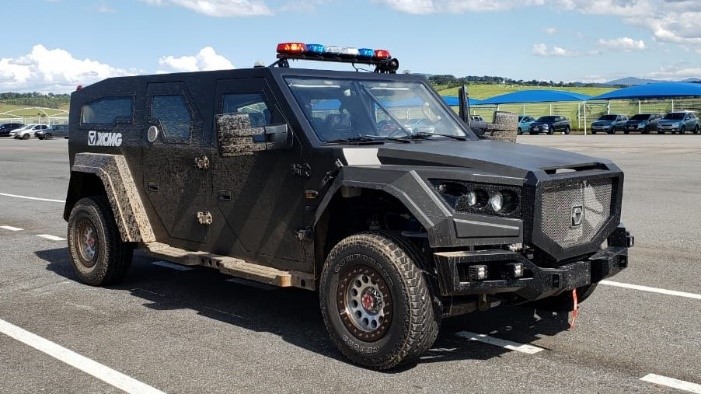
The first tactical vehicles for police forces were adaptations of larger commercial vehicles, such as vans and pickups, which received some kind of ballistic protection, more powerful engines, and some special features or equipment. Although they were able to meet the needs of the time, their performance was greatly hindered by the extra weight added, the change of CG, and the limitations of the suspension. Over time, some factories began to produce tactical vehicles specially designed and built for the performance of these activities.
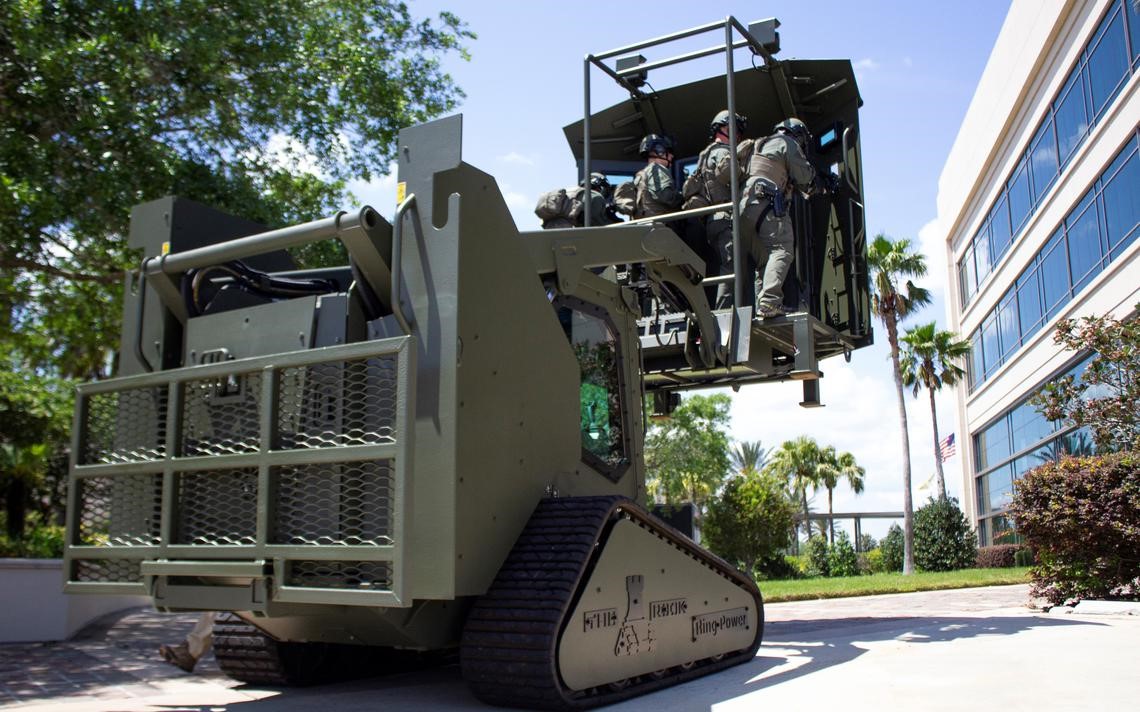
As required by the customer, some vehicles can be built on commercial platforms, which can bring some reduction in operating cost, although these commercial platforms usually limit their operating performance in adverse terrain, reducing the operational capability of the vehicle.
Some special vehicles may be employed for demolition and obstacle removal. In these cases excavators, backhoe loaders or mechanical shovels with reinforced structures adapted to police missions are normally employed, and may have an armored cabin to protect the operators.
Several police forces around the world use armored fighting cars, especially those designed to move elite units such as SWAT. Units operating in specific trouble spots, especially when their opponents employ heavy weaponry, may employ armored vehicles even for routine patrols. SWAT units may also employ armored rescue vehicles for insertion, maneuvering, and removal of personnel during tactical operations, or for the rescue of civilians, firefighters, and police officers trapped by gunfire.
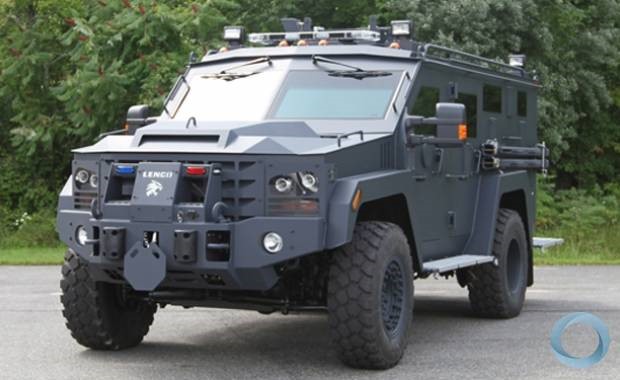
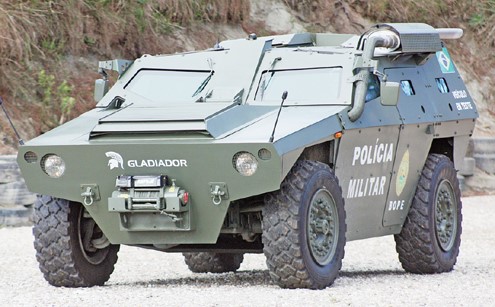
To avoid detection by suspects during insertion into urban environments, special units may also use unmarked vehicles such as buses, vans, trucks, etc. While they may look like normal civilian vehicles, these vehicles usually have most of the features, equipment, and capabilities of operational vehicles.
Many of these vehicles have 4x4 traction, in order to increase their capacity to overcome difficult terrain and smaller obstacles. In some police forces, larger vehicles with 6x6 traction and ballistic armor are used.
Below are some types of tactical vehicles and police vehicles that can receive ballistic protection, as needed.
Vehicle for transporting prisoners - vans, buses or trucks are usually used, specially adapted for transporting detainees from one secure area, such as a prison or court, to another. Aircraft, railcars, or boats can also be similarly equipped. These vehicles must be secured and may feature bars or wire mesh over the windows, segregated prisoner compartments, and additional seating for escort officers. They may be fitted with lightweight ballistic protection to make it more difficult to attempt the release of the transported detainees, or simply bulletproof glass.
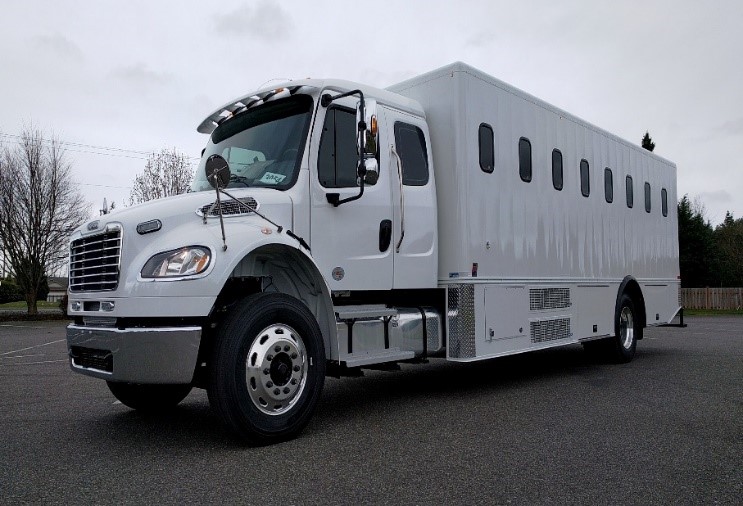
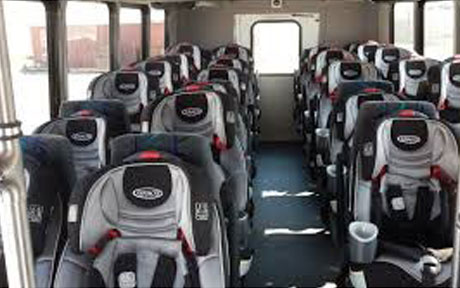
Because their capacity for self-defence is relatively low, prisoner transport vehicles usually receive escorts from other police vehicles when they are on their way. Especially when transporting prisoners of high risk or of high interest to justice. To increase security, prisoners usually wear individual restraint devices and may be physically handcuffed to the vehicle.
Police Bus - normally used to transport groups of special troops, during their displacement from the barracks or police unit to the vicinity of the action scene, where the operational use of the troops will take place. This type of vehicle can receive medium ballistic protection (NIJ Level 3 or 3+) and receive special opening devices that allow the aim and firing of personal weapons to provide self-defense of the vehicle or tools for cleaning the path in front of the vehicle.
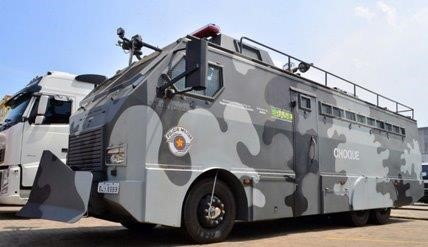
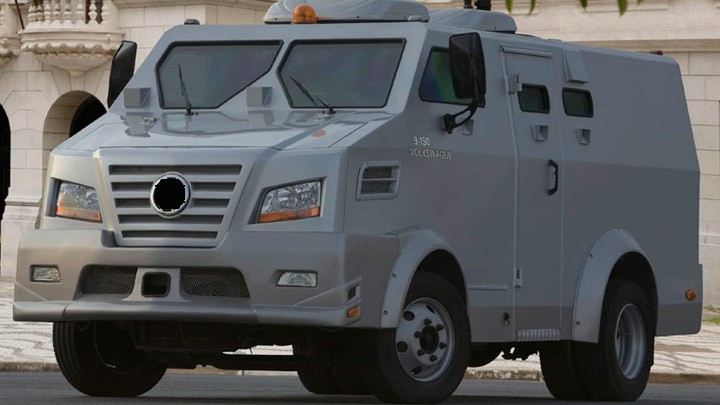
Special Valuables Transport Vehicle - VETV, popularly known in Brazil as "carro-forte", is a special motor vehicle used to transport large amounts of cash, jewelry, documents, and other high-value merchandise. Originally employed by banks, jewelry stores, and museums, today it is used by large companies that, in their commercial activities, receive cash values and need to have these values collected at the end of the day and delivered to the banks where they have an account.
Normally built on commercial truck chassis, they receive heavy ballistic protection and internal devices that allow firefighting, filtering of toxic gases, and the survival of their crew in case of attack by criminals.
It has permanent satellite tracking and radio reception and transmission equipment, in order to maintain permanent communication with the base of operations. The most recent models can also have an internal and external camera system, which transmits, live and permanently, internal and external images of the vehicle, allowing perfect observation and monitoring of the present security conditions.
Inside, they have one or more safes, called manholes, for the deposit and safekeeping of the amounts received. The items that are deposited in these vaults can only be removed at the base of operations, through the use of a specific coded key.
Normally the internal door that gives access to the place where the vaults are located can only be opened by remote request to the risk management center of each company, which will only release it if it observes that the internal and external conditions are within the expected normality.
Water Launch Vehicle - A vehicle that has a cannon for launching a high-power, high-speed stream of water over medium to long distances. It can be used for firefighting, washing large vehicles, and mining activities. However, its police use is for riot control, by dispersing groups of people that are causing the disturbance. Initially, they were created for use on tugboats, to extinguish fires on ships, given the large amount of water around the tugboat.
For water cannons to be installed on land vehicles, a high-flow, high-capacity water source was required, or the presence of a reservoir on the vehicle itself. The first use of the tanker-mounted water cannon for riot control took place in Germany in the early 1930s. The most modern versions do not expose the operator to the commotion and are controlled remotely from inside the vehicle by a joystick.
. In addition, the water pressure is automatically adjusted according to the cannon's angle of deflection to ensure that the intensity of the jet hitting people does not cause permanent harm.
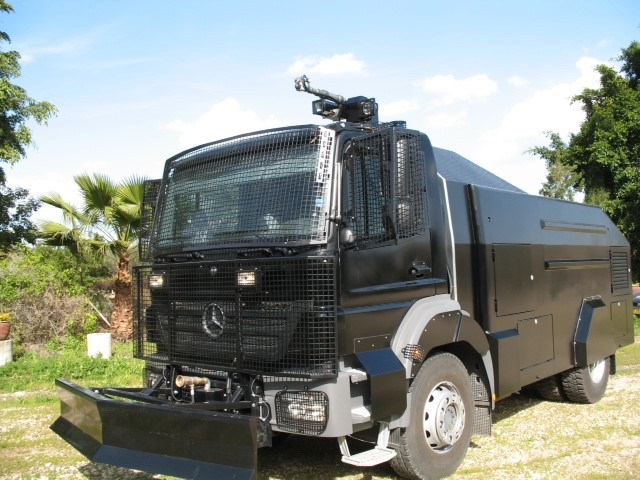
Modern ALVs can have a 10,000 liter capacity reservoir and deliver water in all directions from one, two, or more cannons, all controlled remotely from inside the vehicle by joystick, delivering water at rates of around 20 liters per second.
They can also incorporate separate tanks for different types of liquids to be thrown, such as colored water, which mark those hit, to make it easier to arrest the protesters later. Most modern VLA are also capable of adding tear gas to the water stream.
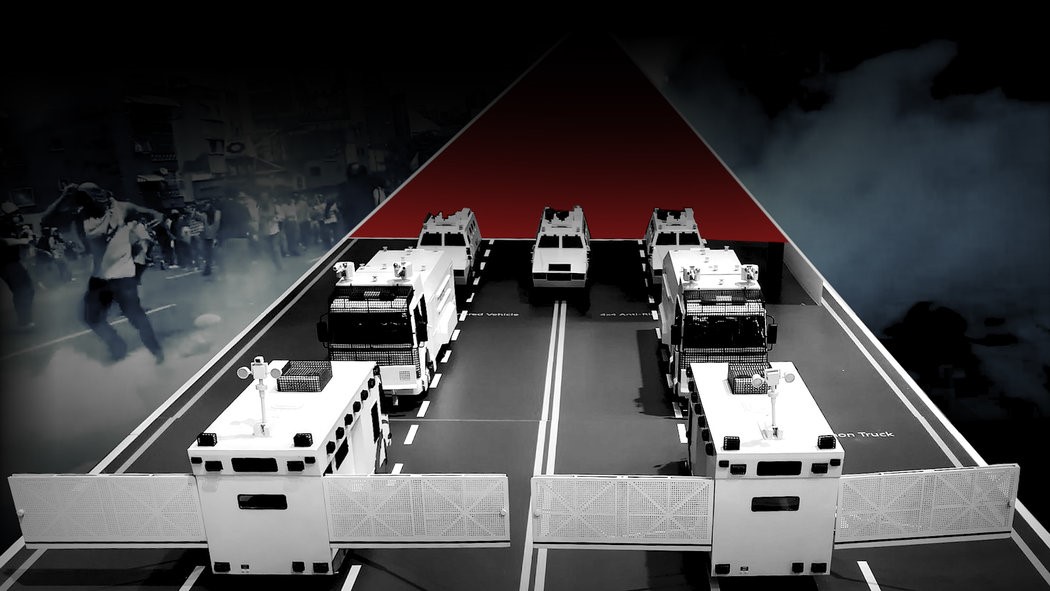
Road Interdiction Vehicle - This is a vehicle that receives a kind of extendable and articulated grid on its side. This grid, under command of the operator, can be fired to the sides and expanded, reaching widths of eight or more meters. Two such vehicles, side by side, are enough to totally close a traffic lane of up to three lanes each. It is important to note that this closure, which was traditionally carried out by policemen on foot, used to retain up to 12 men to close the same useful width, who were no longer employed in other tactical actions.
In addition, the manned barrier is more fragile and puts the police at a high risk of being hit by objects thrown by the protesters, including stones and Molotov cocktails (incendiary combustible liquids). The use of vehicles to block roads frees these officers for more important tactical actions.
Obstacle-Covering Vehicle - Many times, in order to occupy buildings, either for tactical assaults or to reach privileged positions for snipers or other tactical needs, police officers are faced with vertical obstacles whose crossing could delay the troop's advance by important minutes, especially if carrying heavy or bulky tactical equipment.
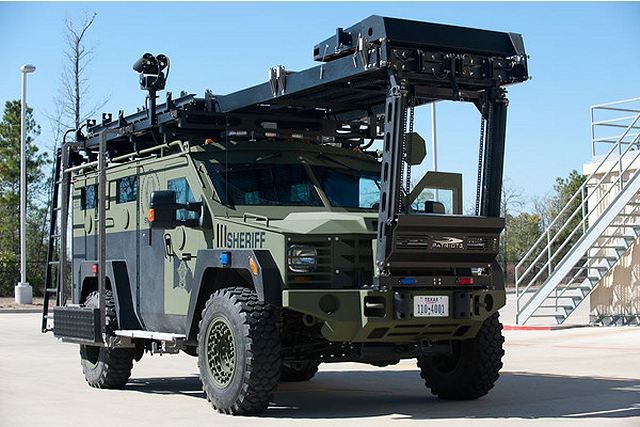
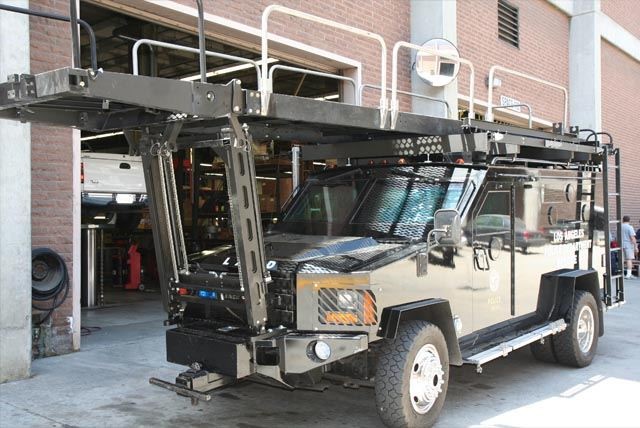
Obstacle-crossing vehicles reduce or even eliminate this delay. They are usually commercial vehicles of the pickup truck or SUV type that have a kind of extendable ramp on the top that, when expanded, can be projected forward and upward, allowing the troop to use it to go over obstacles that may be walls, large unevennesses, or even to enter the building on the first or even the second floor.
Tactical Police Troop Transport Vehicle - Armored vehicle for transporting tactical police units. It can carry from eight to fifteen officers, depending on the model and size of the vehicle, and is normally used for the displacement and incursion of complete tactical units into territory where armed opposition from criminal groups may be encountered. In Brazil, these vehicles have received the name "Caveirão" (big skull).
Although they can often be built on commercial chassis, they receive a specially designed and manufactured body to shelter the troops protected from gunfire (ballistic protection) and to allow their displacement under adverse combat conditions. They are equipped with dartboards, which are holes that allow long guns to be inserted and shot from inside the vehicle. Most have an external turret that allows one or two policemen to have part of their body projected upwards, protected by a ballistic half-wall, and to fire their personal weapons at eventual opponents or attackers.
Normally with all-wheel drive, high suspension, and high power and torque available in the engine, it can accelerate quickly and reach speeds of up to 120 km/h, allowing the rapid advance and removal of the vehicle from the scene.
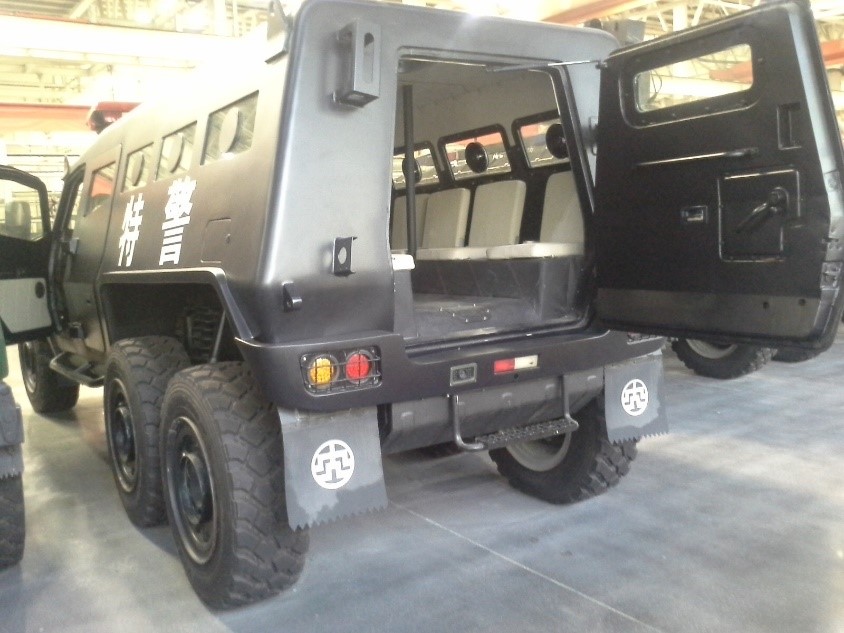
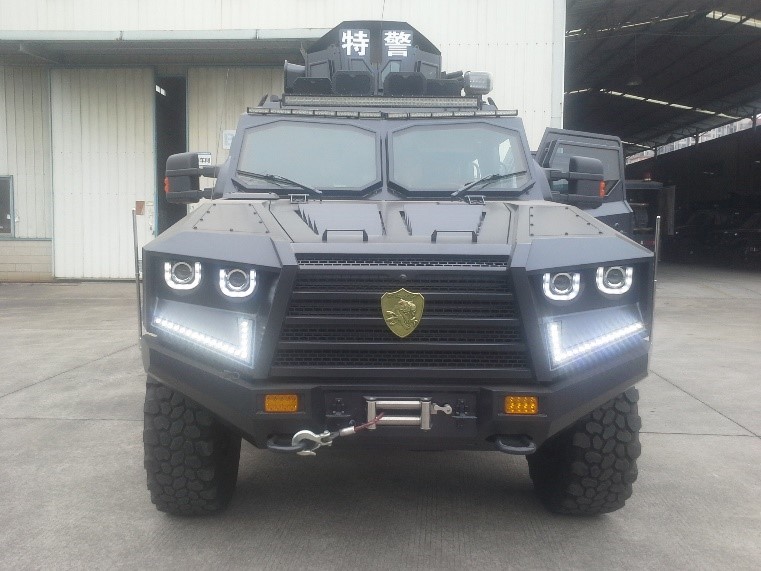
Spacious, they provide space for a small amount of extra armament and ammunition, for troop recompletion. It can also have, on the outside, next to the turret, launchers for less lethal weapons, including smoke, pepper, or tear grenades, and loudspeakers for messages to the population. It is not characterized as an attack vehicle, but rather as a support vehicle for tactical actions, and is also used to rescue injured police officers and civilians in places under threat from criminals.
Due to its large size, this type of vehicle ends up having its maneuverability impaired and presents severe restrictions for operation along the usually narrow streets existing in most communities. The most modern models have ABS brakes and an air-conditioning system with cooling capacity even when the engine is turned off (in case it is damaged), and tires capable of running for up to 20 kilometers if deflated or hit by gunfire. Some have a track clearing system in the form of a hydraulically driven track cleaner, which has the capacity to remove small obstacles that may be placed along the track. Ballistic protection can be improved by adding a capability to resist explosions from the ground.
Medium Tactical Transport Vehicle - This is an armored vehicle for tactical transport, built similarly to the Caveirões, but with smaller dimensions, for the transport of up to five armed and equipped police officers.
. Like their larger brothers, they count with the same protection systems, turret, ability to shoot from inside the vehicle, similar ballistic protection, high suspension, ABS brakes, and high engine power. Due to their reduced dimensions, they have greater maneuverability in narrow streets, such as those found in most communities, allowing faster advance and retraction.
They also have a significantly lower cost, making them suitable and ideal to be acquired not only by special tactical units, such as Special Operations Battalions and Shock Battalions, but by all police infantry units and battalions.
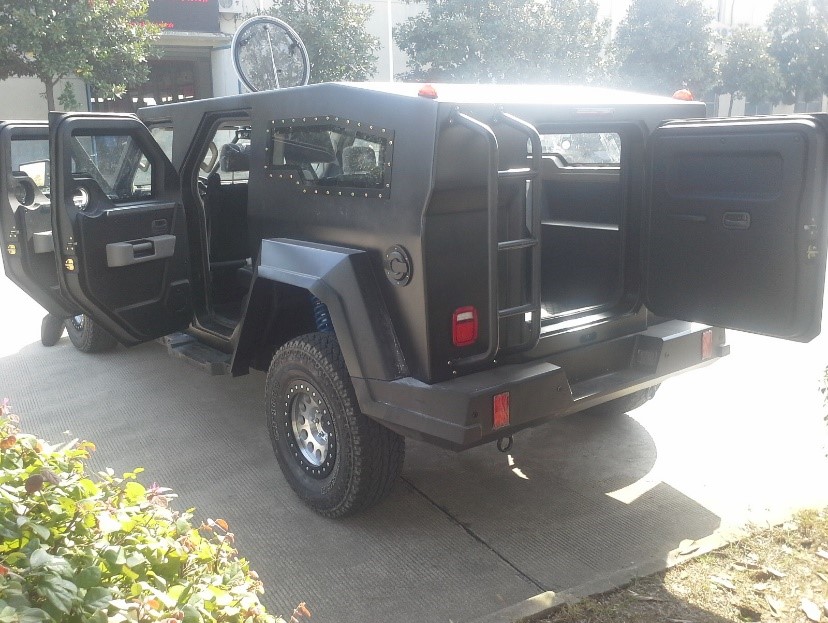
They have good capacity to transport weapons and ammunition to replenish the team deployed and, due to their agility and ballistic protection, they are ideal for rescuing police officers under enemy fire. Originally, the vehicle carries five police officers, two in the front and three in the back. As it has four doors, the entry and exit of personnel occurs quickly. The vehicle also has a large rear space that can accommodate weapons, ammunition, equipment, and even other evacuated police officers or civilians. The rear middle passenger has access to the center turret.
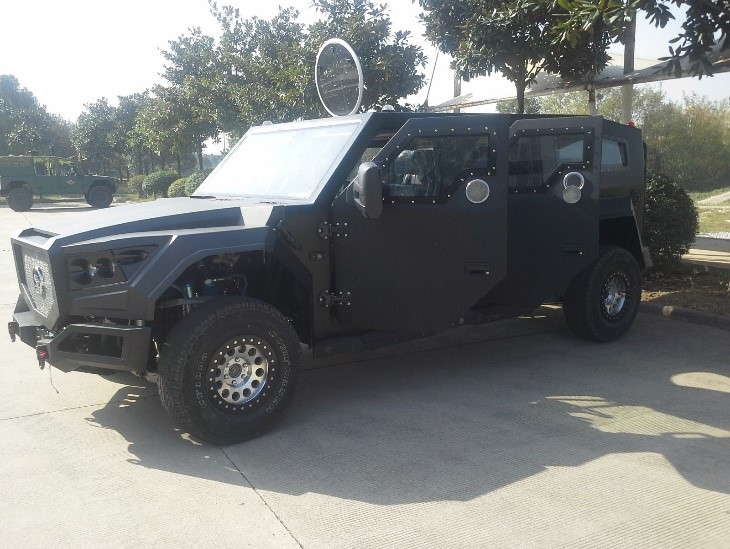
The rear middle passenger has access to the center turret. The rear seats can be removed to make room for up to two stretchers. This original configuration can be customized, according to the buyer's needs, even allowing for an increase in carrying capacity. Because it has an especially high suspension and excellent entry and exit angles and maximum lateral tilt, enhanced by the four-wheel drive and differential with manual locking, the vehicle is also ideal for operating on uneven ground, such as open country and the caatinga region.
Light Tactical Transport Vehicle - This is an armored vehicle very similar to the previous one, but with even smaller dimensions, with capacity for the tactical transport of 04 people. It has the same protection resources, turret, ability to shoot from inside the vehicle, similar ballistic protection, high suspension, ABS brakes, and high engine power.
As their dimensions are minimal, they have the best maneuverability on narrow roads in the segment. They also have the lowest cost in the segment, making them ideal to be acquired by any and all police units. They have good capacity to transport weapons and ammunition to replenish the displaced team and, due to their agility and ballistic protection, they are ideal for rescuing officers who are under adversary fire.
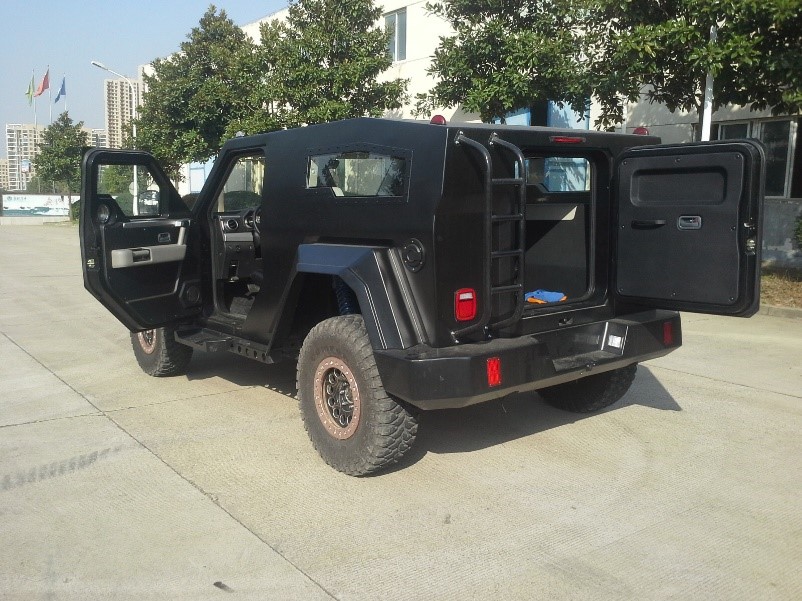
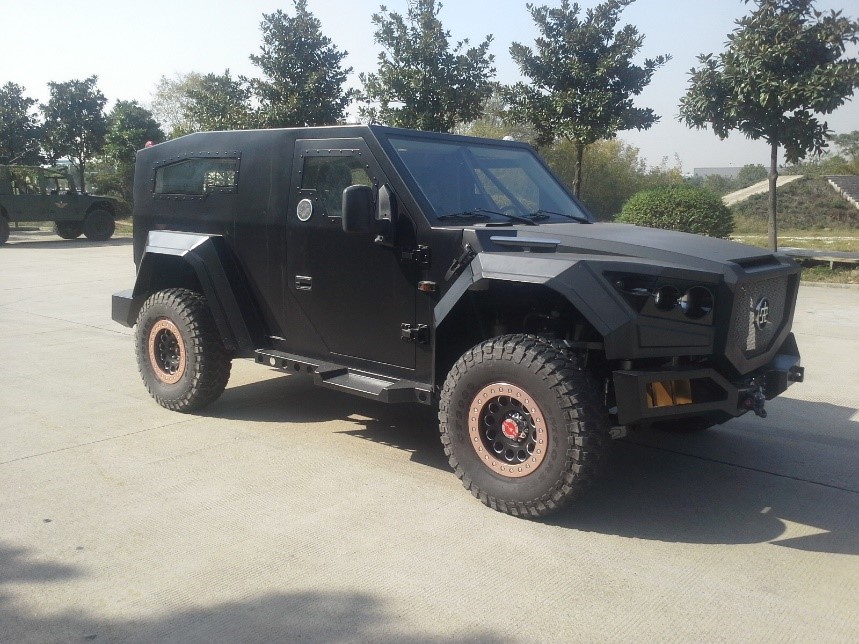
Originally, the vehicle carries four police officers, two in the front and two in the back. As it has only two doors, the entry and exit of personnel occurs less quickly, requiring some coordination. The vehicle has a rear space that can accommodate weapons, ammunition, equipment, and even other evacuated police officers or civilians. Access to the central turret is easily reached by either of the two rear passengers. The rear seats can be removed to make room for a stretcher.
Due to its especially high suspension, excellent entry and exit angles and maximum lateral tilt, low weight and center of gravity, enhanced by four-wheel drive and differential with manual locking, the vehicle is perfect for operating on uneven ground, such as open country and the caatinga region.
Accessories for Tactical Transportation
In addition to tactical vehicles, QUARTZO has accessory equipment in its portfolio for the performance of tactical and operational transport activities and vehicle traffic control operations. Among them, a trailer for motorcycles that weighs only 65 kg and is totally dismountable. The RE.BO.Q, which, disassembled, is kept in a canvas bag for easy transportation, can be stored in the trunk of any small vehicle. The equipment is approved by the Brazilian regulatory agencies and, despite its light weight, is approved for transporting heavy motorcycles (up to 445 kg), such as those used for tactical escort actions. The detachable trailer RE.BO.Q is the exact answer for the transport and rescue of motorcycles for tactical use. vehicle. Its disassembly is easily done by a single person, without the need for any tools.
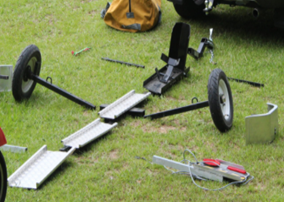
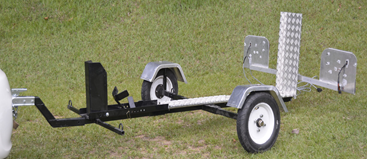
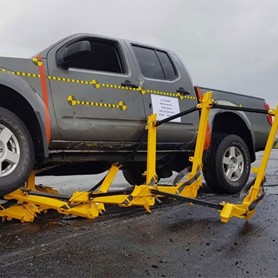
QUARTZO Defense Engineering also makes available tactical mobile barriers that provide total safety to the traffic teams, since they are capable of interrupting, in a few meters, the advance of any vehicle that deliberately decides to disrespect the obstacles and pass through them, thus avoiding hitting the traffic teams. Lightweight and easily carried in bags that fit in the trunk of any small vehicle, they are quickly assembled by a single person. Despite their lightness, depending on the model, they are capable of containing the advance of even heavy trucks and trailers.
QUARTZO Defense Engineering has a vast portfolio of tactical and special operations police vehicles, both for the displacement of small and large tactical units. The vehicles can be armored or not, according to operational needs and allow some degree of customization to meet specific needs of the police force. It also offers accessory equipment for carrying out operations with these vehicles and for traffic control. The accessory equipment vehicles offered by QUARTZO are robust, tested in real-life confrontation situations and approved by the most modern American and European safety and emission control standards. Please contact us and let us know your needs in terms of tactical vehicles and equipment for traffic control. We will be happy to help you.
Vehicles and Industrial Machinery
Forklift trucks - for the organization of stocks and the movement of loads in logistics centers, warehouses or factories, the use of specialized machines such as mechanized forklift trucks optimizes the operational routine, reducing operation time and its associated costs and increasing the safety of the work performed. Regardless of the size, whether large factories or logistics distribution centers or small workshops and warehouses, reach trucks are essential because of their great capacity to move and lift loads, as well as their agility to move in narrow aisles, typically found between storage racks.

The combustion-powered forklifts, unique in the past, usually have a more robust structure, ideal for transporting heavier loads (up to 4,000kg) and move with greater speed, providing excellent productivity in terms of weight transported per time worked.
Electric forklifts are smaller (medium or small), and are most often used in warehouses or storerooms. Especially those where the space does not recommend the presence of equipment with combustion engines that generate exhaust gases, such as closed, refrigerated, food and medicine warehouses, or other items where the presence of toxic gases is not recommended.
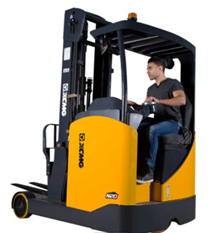
Until a few years ago, combustion forklift trucks were the main solution for moving and storing heavy materials on high shelves. However, electric forklift trucks have become a trend, mainly due to environmental factors and work ergonomics, since they shake less and generate less noise. Consumption is another point in favor, with electric propulsion bringing savings of more than 60% over combustion models.
Lifting platforms - safety during the execution of work at height is of capital importance and has been an increasingly frequent target of inspection by labor authorities and the object of attention of CIPA's of companies. The Regulatory Standard NR35 establishes the minimum requirements and protective measures for work at height, involving its planning, organization, and execution, and seeking to ensure the safety and health of workers involved directly or indirectly with this type of work, even if occasionally. For these reasons, the measures that aim to ensure the worker's safety when performing activities at height have been improved and new, more powerful, capable, efficient and safe equipment has been developed and presented to the market.
The QUARTZO Group brings to the Brazilian market electric elevator platforms with advanced steering control technology, which facilitate the entrance in areas with limited space, providing safe and reliable steering with reduced turning radius, contributing to the safety and efficiency in the operations.
Mobile Elevating Work Platforms (MTWPs) have come a long way since the 1920s, when large wooden platforms began being mounted on the backs of trucks to help workers reach objects at height. These makeshift truck-mounted platforms spread rapidly around the world and modernization of their design was driven by the growing need to perform public services at height such as electrical distribution networks, street lighting poles, tree pruning, and reaching high floors for incoming and outgoing loads and firefighting.
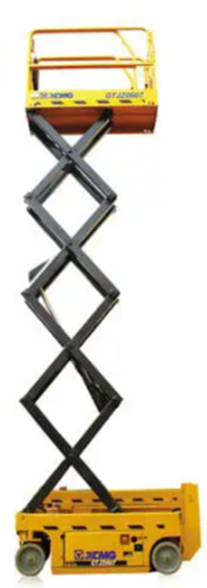
Today's PEMTs feature advanced technology, precision positioning, and high load capacity, some exceeding 320kg at over 15 meters high. Services that used to be highly complex and risky for workers are now easily overcome with the use of this equipment.
One of the precursors and currently among the largest manufacturers of industrial machinery in the world, XCMG do Brasil has a wide range of Mobile Elevating Work Platforms, with the option of customizing the equipment to better meet specific customer needs. Among them, stands out the newest release of the brand, the GTJZ0607.
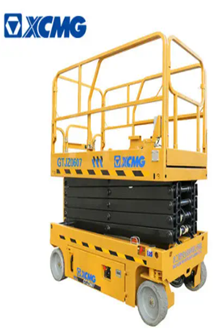
The PEMT model GTJZ0607 presents a versatile compact structure, ideal for jobs in reduced spaces. Thanks to its new electric drive system, its driving is smoother, quieter, more precise, and completely emission-free, improving the comfort not only of the equipment operators and workers on the platform, but also of all those in its vicinity. With autonomous operation systems and automatic handling protection, the GTJZ0607 is focused on serving the civil construction and maintenance markets of commercial buildings, warehouses, factories, airports, monuments, elevated structures and the most diverse spaces where work at height is required.
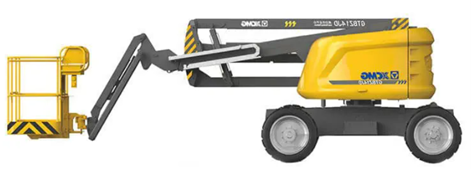
XCMG, the world's fourth largest company in the segment of industrial machinery and for civil construction and a partner of the QUARTZO Group, is prepared to absorb the national demand for industrial machinery with modern, high quality, reliable and cost-effective equipment. Its gigantic factory, with more than 1,000,000 m², installed in Pouso Alegre, Minas Gerais state, ensures not only the guarantee of the products offered, but also their corrective, preventive and predictive maintenance. The excellent technical training provided by XCMG is an essential factor for the best use by the customer of all the technology offered by our products. XCMG also has a distribution center for parts and services for Latin America, based in the city of Guarulhos - SP, with an area exceeding 50,000 m², where is also located a training center accredited by the factory. For the entire XCMG product portfolio, it is available the possibility of acquisition through FINAME credit line and the factory's own bank (XCMG Bank).
The QUARTZO Group offers lift platforms and electric forklifts for performing services with safety, quality, reliability, productivity and, in the electric models, without damaging the environment. These are state-of-the-art equipments that assure high efficiency and bring results with excellent cost-benefit relation. QUARTZO, in its continuous search for high quality products, offers exclusively to its customers the modern, safe and efficient industrial vehicles from XCMG, one of the main players in the world market, with maintenance in Brazil.
